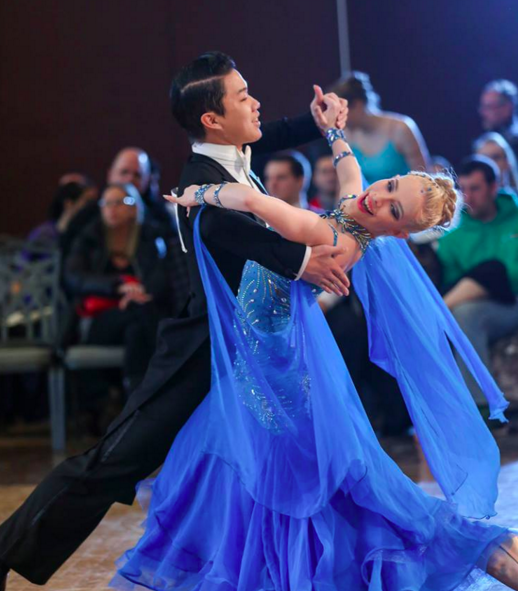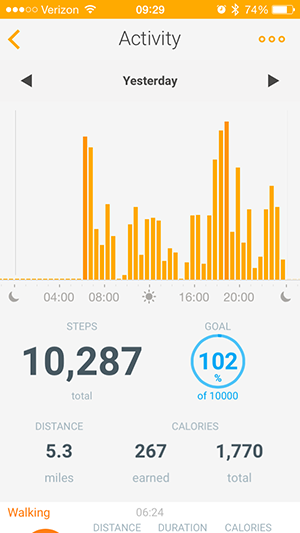
Ballroom dance isn’t newfangled — the first mention of it comes from a dusty book published in France way back in 1588. Flash forward more than 400 years and ballroom dance is still going strong, and competitions have all but exploded. Read on for our interview with a DanceSport competitor and see our blogger’s impressive ballroom dance activity graph.
Maybe it’s thanks to Dancing with the Stars hosting everyone from ice skating champions to the children of politicians, but for whatever reason, studios are cropping up all across the country ready to teach even the clumsiest of us how to cha-cha. While plenty of dancers do it just for fun and to burn a couple extra calories, many face the competition head on in what is commonly known as DanceSport, one of the most athletic forms of dance.

I met up with Boston-based competitive dancer Marissa Skye Pioso, pictured above, to see why she got into the sport and where it has taken her. Incidentally, we met during a sweat-soaked ballroom ‘social’ hosted by MIT. After four straight hours of non stop dance, and switching between slow waltzes and powerful sambas, we stopped to chat between shoe changes. Marissa is relatively new to the ballroom world, joining competitions in 2012 because she wanted to try something new and take a break from her previous dance love, ballet. She was also excited to dive into a team sport, and enjoys the support her team and fellow dancers give her. That’s a funny thing about competitive ballroom, you’re on a ‘team’ even though judging is based entirely on just you and your partner. Marissa says her favorite aspect of the competition is that it’s “you and your partner against the world.”

When the dancers hit the floor, their movements look nearly effortless — and that’s the point, but it’s anything but. Even the ‘calmest’ dance, the waltz, engages your core, arms, back, and butt really well, making for a great overall toned experience. With my Activité Pop strapped on, I could see we burned about 200 calories during the hour-long practice, and twice that during the fast dances like cha-cha, samba, and jive.
When not training for competition, Marissa doesn’t just sit back and relax. Her favorite exercise for preparing is all things cardio, because during competition it’s go go go. To keep up her stamina for the full two days of competition, she makes sure to eat well and fit in time on the elliptical, her preferred cardio exercise, whenever she can. While on site at competitions, which often takes place in university gyms and dance halls decked out in glitter, Marissa chows down on protein bars, bananas, and Fage Greek yogurt to keep her energy up in between competition rounds.
Competition ballroom dance is hardcore anaerobic exercise. A routine is performed to a 90-second music segment. This means that the oxidative part of your energy system simply can’t keep up with the short but high intensity demanded by a good performance and leaves you dripping with sweat. So while Marissa does stretch and work on her flexibility a lot, it’s the anaerobic exercise, sprints, and high intensity workouts, and lots of competition-style rounds, that really help prepare her for competitions.
While most professional competitors focus on one of four traditional styles of dance: Latin or Rhythm, for sexier and fast-paced action, versus Standard or Smooth, for your decadent Waltzes, Foxtrots and the like, amateur competitors will often try their hand at multiple styles. Marissa’s favorite Latin dance samba for her Latin routines and waltz for her standard ones, but both provide ample calorie burning and play on her flexibility.
When asked if she’d recommend ballroom to others, Marissa answers ‘yes’ without hesitation. “It’s a great way to meet new people, and exercise without feeling like you’re trapped in a gym!” she says. You don’t have to be a fierce competitor to reap the benefits of fun exercise. Ballroom dancing is a great reason to strengthen the muscles you forgot were holding up your back or powering your legs, not to mention see crazy improvements in grace and hand-eye coordination that dancers all work very hard to maintain.
The best part? Because ballroom has gotten so big in the real world, there’s no reason to wait. Find the closest studio to you — and get dancing.



